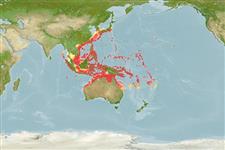| Native range | Point map | Year 2100 |

|
| Decapterus maruadsi AquaMaps Data sources: GBIF OBIS |
Length at first maturity
Lm ?, range 10 - 15 cm
Human uses
Fisheries: highly commercial
Phylogenetic diversity index
(Ref. 82805)
PD50 = 0.5010 many relatives (e.g. carps) 0.5 - 2.0 few relatives (e.g. lungfishes)
Trophic Level
(Ref. 69278)
3.4 ±0.45 se; Based on food items.
Resilience
(Ref. 69278)
High, minimum population doubling time less than 15 months (K=0.5-1.3; tmax=9)